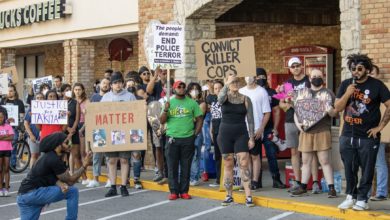On Dec. 30, 2009, while most families were enjoying the holidays and preparing for the new year, others prepared candles and placards in an expression of mourning and outrage. The family of Kenny Lazo held a vigil in front of the Suffolk County police precinct where on April 12, 2008, he was beaten and left to die in a jail cell. Over 30 family members, friends and activists braved the 24-degree weather to remember Lazo on what would have been his 26th birthday.
In April 2008, Kenny was beaten with flashlights by five police officers while in their custody. He
 Patricia Gonzalez and Lisa Bryant, two mothers whose sons have been killed by Suffolk County police. |
suffered severe blows to the skull and the face. An independent autopsy concluded that he was choked with a flashlight while handcuffed and face down. Although the coroner ruled his death a homicide, the district attorney did not vigorously pursue indictment. For nearly two years, Lazo’s family has been fighting tooth and nail for the disclosure of all the facts related to his death and for the prosecution of the cops who killed him.
At the vigil, Kenny’s grief-stricken mother Patricia Gonzalez explained, “I just want justice. I need justice.”
One community member in attendance, Lisa Bryant, made clear that Lazo’s case is not an isolated incident. She, too, recently lost her son, Eric Johnson, at the hands of the Suffolk County Police. She arrived at the vigil holding a placard with photos of both her son and Lazo.
With outrage and indignation, she explained that on Oct. 27, 2009, Johnson was shot in the back by an off-duty police officer at a gas station in Deer Park, Long Island. Not only had Johnson been shot, but the officer had also left him there to die. Police officers of the 1st precinct were called to the scene, but he was already dead. He bled to death five minutes away from the nearest hospital.
The police department refuses to disclose the name of the off-duty police officer who took the life of yet another member of our community and our class. The District Attorney’s office is in possession of a video taken of the entire event but has refused to disclose it to Johnson’s family. Ms. Bryant’s request for the autopsy report was likewise declined by the district attorney.
After speaking out at the vigil, Ms. Bryant embraced Ms. Gonzalez—an emotional display of solidarity between two mothers sharing the same pain, and the same desire for justice. “They (police officers) knew my son,” Ms. Bryant told Liberation newspaper. “He was a member of the police athletics league, he was a boxer in the league.” Ms. Bryant is working to bring awareness of the murder of her son, and the family is planning to hold a vigil at the site of the murder in the coming weeks.
Not an isolated incident in an isolated town
Police brutality is not the work of a few rotten apples. The police are an integral part of the state, used to strike fear into poor and working communities all over the country. In African American and Latino neighborhoods in particular, police are given a free pass to dish out violence and abuse, using their guns and badges to play the role of judge, jury and, all too often, executioner.
This holds true as much in the small towns of Long Island as it does in New York City a few miles to the west. In recent years, more Latino immigrants have moved to Suffolk County in search of work. They have been targeted in a wave of racist bigotry from the area’s political establishment and its officers on patrol. The police, courts and media use racist stereotypes to justify the killings of our community members, using drug and gang implications to justify such murders. They broadcast, implicitly or explicitly, the false message that “our community is better off without them” in an effort to deflect attention away from police crimes. That attitude needs to be checked and countered with a movement that will not rest until justice is won for Kenny Lazo, Eric Johnson and all the other victims of police brutality.






